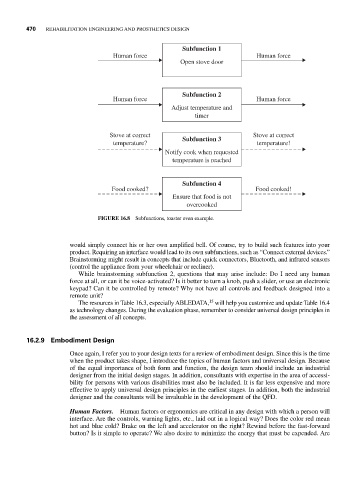Page 492 - Biomedical Engineering and Design Handbook Volume 2, Applications
P. 492
470 REHABILITATION ENGINEERING AND PROSTHETICS DESIGN
Subfunction 1
Human force Human force
Open stove door
Subfunction 2
Human force Human force
Adjust temperature and
timer
Stove at correct Stove at correct
Subfunction 3
temperature? temperature!
Notify cook when requested
temperature is reached
Subfunction 4
Food cooked? Food cooked!
Ensure that food is not
overcooked
FIGURE 16.8 Subfunctions, toaster oven example.
would simply connect his or her own amplified bell. Of course, try to build such features into your
product. Requiring an interface would lead to its own subfunctions, such as “Connect external devices.”
Brainstorming might result in concepts that include quick connectors, Bluetooth, and infrared sensors
(control the appliance from your wheelchair or recliner).
While brainstorming subfunction 2, questions that may arise include: Do I need any human
force at all, or can it be voice-activated? Is it better to turn a knob, push a slider, or use an electronic
keypad? Can it be controlled by remote? Why not have all controls and feedback designed into a
remote unit?
15
The resources in Table 16.3, especially ABLEDATA, will help you customize and update Table 16.4
as technology changes. During the evaluation phase, remember to consider universal design principles in
the assessment of all concepts.
16.2.9 Embodiment Design
Once again, I refer you to your design texts for a review of embodiment design. Since this is the time
when the product takes shape, I introduce the topics of human factors and universal design. Because
of the equal importance of both form and function, the design team should include an industrial
designer from the initial design stages. In addition, consultants with expertise in the area of accessi-
bility for persons with various disabilities must also be included. It is far less expensive and more
effective to apply universal design principles in the earliest stages. In addition, both the industrial
designer and the consultants will be invaluable in the development of the QFD.
Human Factors. Human factors or ergonomics are critical in any design with which a person will
interface. Are the controls, warning lights, etc., laid out in a logical way? Does the color red mean
hot and blue cold? Brake on the left and accelerator on the right? Rewind before the fast-forward
button? Is it simple to operate? We also desire to minimize the energy that must be expended. Are

